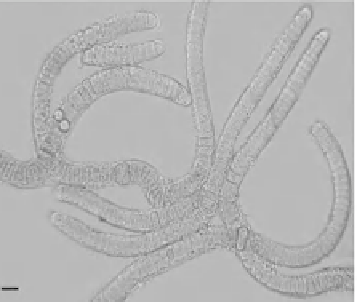Biology Reference
In-Depth Information
Figure 23
: Cyanobacteria from temple monuments of Orissa, India.
Lyngbya
sp (A),
Tolypothrix
sp. (B),
Plectonema
sp. (C) and
Stigonema
sp (D). Magnifi cation bar in all pictures represents 10 µm Pictures courtesy S.P. Adhikary, DBT-HRD Program,
Centre for Biotechnology, Visva-Bharati, Santiniketan-731235, West Bengal, India.
questions in understanding desiccation tolerance (Potts, 1996, 2001, 2005). The synthesis and release
of EPS is a common feature present in many cyanobacterial species as well as by the dominant
cyanobacterial fl ora reported in the soil crusts. Other cyanobacteria like
Gloeocapsa
sp.,
Anabaena
sp. strain PCC 7120,
A
.
variabilis
ATCC 29413
and
N
.
punctiforme
PCC 73102 have also been used for
comparison. Knowledge that has accumulated on desiccation tolerance is presented in the following
sections: (i) targets of desiccation damage in cyanobacterial cells, (ii) physiological studies dealing
with photosynthesis and nitrogen fi xation during desiccation and rehydration, (iii) membrane
modifi cation, (iv) synthesis and structure of EPS and its role in desiccation tolerance; (v) trehalose
synthesis and desiccation tolerance, (vi) synthesis of mycosporine-like amino acids (MAAs) and
(vii) the role of scytonemin in desiccation tolerance.
i) Targets of desiccation damage:
The macromolecules proteins, DNA and lipids appear to be the
main targets of damage during desiccation. When
N
.
commune
UTEX 584 cells grown on Na
2
35
SO
4
were desiccated to a matric water potential of 99.5 MPa (
a
w
=0.5), the cells continued to incorporate S
35
and maintained high levels of chloramphenicol-sensitive protein synthesis for more than 90 min. But





